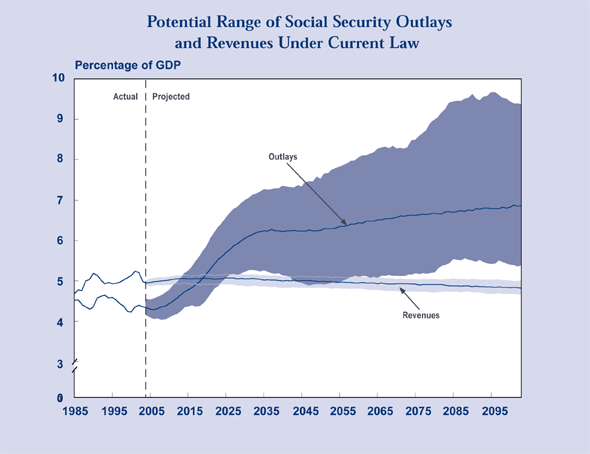| |
|
|
| The Outlook for Social Security |
| |
June 2004 |
|

Notes
All of the years referred to in this study are calendar years.
Numbers in the text and tables may not add up to totals because of rounding.

|
Over the past several years, as lawmakers have become more aware of long-term pressures facing the federal government, the Congressional Budget Office (CBO) has been asked to evaluate the long-term economic and budgetary implications of current laws governing major entitlement programs and of legislative changes to those programs. In accordance with its mission to provide the Congress with budget projections and estimates of the costs of legislation, CBO has sought to enhance its capacity to produce long-term analyses. As a starting point, the agency presented comprehensive 50-year scenarios for the federal budget in December 2003 in The Long-Term Budget Outlook.
This updated study presents more-detailed 100-year projections for Social Security under current law, as a prelude to evaluating any legislation affecting that program. The report focuses on the resource demands of the Social Security system, the program's finances, and projections of the benefits received by individuals in different age and income groups. In keeping with CBO's mandate to provide objective analysis, the study makes no recommendations. (Background on Social Security, including information about the program's structure and financing, underlying demographic trends, and strategies that have been proposed to prepare for the aging of the U.S. population, can be found in an earlier CBO publication, Social Security: A Primer, published in September 2001).
Noah Meyerson, Amy Rehder Harris, and Josh O'Harra of CBO's Health and Human Resources Division wrote this study. They and Kevin Perese, John Sabelhaus, Michael Simpson, and Julie Topoleski contributed to the underlying research and techniques. Paul Cullinan, Robert Dennis, Douglas Hamilton, Arlene Holen, Ben Page, Elizabeth Robinson, John Sabelhaus, Robert Shackleton, Ralph Smith, Robert Sunshine, and Thomas Woodward reviewed the study and provided helpful comments.
Members of CBO's Long-Term Modeling Advisory Panel--Barry P. Bosworth, Dan L. Crippen, Roland (Guy) King, Thomas E. MaCurdy, Olivia S. Mitchell, John Rust, Sylvester J. Schieber, and C. Eugene Steuerle--provided considerable assistance in reviewing this analysis. In addition, many analysts from the Social Security Administration's Office of the Chief Actuary were generous in contributing their time and sharing data. (The assistance of such external participants implies no responsibility for the final product, which rests solely with CBO.)
Christian Spoor edited the study, and John Skeen proofread it. Maureen Costantino produced the cover and prepared the report for publication. Lenny Skutnik printed the initial copies, and Annette Kalicki prepared the electronic versions for CBO's Web site.
Douglas Holtz-Eakin
Director
June 2004
| Tables |
| |
|
| 1-1. |
Social Security Outlays and Revenues in Selected Years, 2003 to 2100 |
| 1-2. |
Summarized Social Security Outlays, Revenues, and Balances |
| 2-1. |
Measures of the Benefits Received by the Median Retired Worker, by Birth Cohort and Earnings Level |
| A-1. |
CBO's and the Social Security Trustees' Long-Term Economic Assumptions |
| B-1. |
Measures of the Benefits Received by the Median Retired Worker, by Sex, Birth Cohort, and Earnings Level |
| |
|
| Figures |
| |
|
| S-1. |
Projected Social Security Outlays and Revenues Under Current Law, 1985 to 2103 |
| 1-1. |
Projected Social Security Outlays and Revenues Under Current Law, 1985 to 2103 |
| 1-2. |
The OASDI Trust Fund Ratio, 1985 to 2103 |
| 1-3. |
Outlays for Benefits Under Current Law and Under Projections of Trust Fund Balances, 1985 to 2103 |
| 2-1. |
Median First-Year Retirement Benefits, by Birth Cohort |
| 2-2. |
Median Replacement Rates, by Birth Cohort |
| 2-3. |
Median Lifetime Retirement Benefits, by Birth Cohort |
| 2-4. |
Potential Range of Lifetime Payroll Taxes, by Birth Cohort and Earnings Level |
| 2-5. |
Potential Range of Lifetime OASDI Benefits, by Birth Cohort and Earnings Level |
| 2-6. |
Potential Range of the Ratio of Lifetime OASDI Benefits to Lifetime Payroll Taxes, by Birth Cohort and Earnings Level |
| A-1. |
CBO's and the Social Security Trustees' Projections of Annual Social Security Outlays and Revenues, 1985 to 2080 |
| |
|
| Box |
| |
|
| 3-1. |
Projecting the Taxation of Benefits Under Different Assumptions About Future Income Tax Rates |
|

